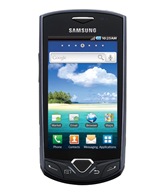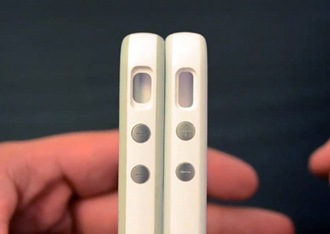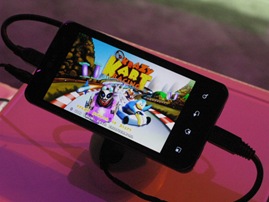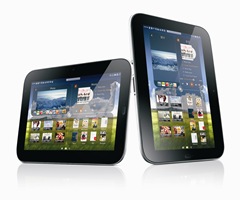 Motorola Mobility, Inc. (NYSE: MMI), and AT&T today unveiled Motorola ATRIX� 4G, the only smartphone that allows you to carry the power of mobile computing inside your pocket. Motorola�s revolutionary webtop application changes mobile computing forever by unleashing the power of the smartphone like never before. Designed to bring unprecedented computing to your smartphone, Motorola�s webtop application runs a full Mozilla Firefox 3.6 browser and supports Adobe� Flash� Player to open up all the rich graphics, animations and video on the web. Motorola ATRIX 4G includes a dual core processor with each core running at 1 GHz, delivering up to two GHz of processing power. Put simply, Motorola ATRIX 4G is the world�s most powerful smartphone.
Motorola Mobility, Inc. (NYSE: MMI), and AT&T today unveiled Motorola ATRIX� 4G, the only smartphone that allows you to carry the power of mobile computing inside your pocket. Motorola�s revolutionary webtop application changes mobile computing forever by unleashing the power of the smartphone like never before. Designed to bring unprecedented computing to your smartphone, Motorola�s webtop application runs a full Mozilla Firefox 3.6 browser and supports Adobe� Flash� Player to open up all the rich graphics, animations and video on the web. Motorola ATRIX 4G includes a dual core processor with each core running at 1 GHz, delivering up to two GHz of processing power. Put simply, Motorola ATRIX 4G is the world�s most powerful smartphone.
�Consumers are increasingly using smartphones as their primary digital screens,� said Bill Ogle, chief marketing officer, Motorola Mobility, Inc. �Motorola ATRIX 4G ushers in a new era of mobile computing. ATRIX comes loaded with the Motorola webtop application, and when used with one of our exclusive docks, enables consumers to extend the capabilities of their smartphones. Together, these provide a revolutionary interactive computing experience that empowers individuals in new ways for staying connected, informed and entertained at home, on the job and anywhere in between.�
�With ATRIX 4G, we are rethinking what a smartphone can be, and literally changing the game with a new device category that combines the power of a laptop with the latest smartphone features and 4G speeds,� said David Christopher, chief marketing officer, AT&T mobility and consumer markets. �With Motorola Mobility, we�re delivering on our commitment to provide customers with the best mobile broadband experience and best smartphones.�
Motorola ATRIX 4G is designed to essentially become a user�s primary digital hub to create, edit and interact with documents, media and content. This is facilitated by Motorola�s webtop application and incredible new accessory docks, such as the Laptop Dock, that provide users with a larger screen, keyboard and trackpad enabling them to have an enhanced and more interactive computer-like experience with their devices.
While in the webtop application users can run their Android applications in a window, browse their favorite websites with a full Firefox desktop browser, send instant messages and make phone calls, all at the same time. Calls continue uninterrupted if Motorola ATRIX 4G is removed from a dock. Users can take advantage of the ability to surf the web, view social networking, and use HTML5 web-based applications and supported cloud computing services. Plus, the new Entertainment Center feature lets you show all of the photos, music and videos you already enjoy on-the-go on a big screen in your living room. In the U.S., ATRIX 4G will feature the AT&T U-verse� Mobile application, which allows users to schedule recordings, and for qualifying TV customers, download and watch hit TV shows on their smartphones.
Motorola ATRIX 4G provides consumers with instantaneous access to all their emails, files and media. While using the webtop application, business users with an existing Citrix account will benefit from the integrated Citrix Receiver application that provides secure, high performance access to virtual desktops as well as Windows�, web and office applications hosted on Citrix XenDesktop. In addition to the full suite of office productivity applications and email applications, users can also access a great number of web applications such as Salesforce.com, Google Docs, and any HTML application or service from the full desktop browser.
Motorola ATRIX 4G runs Android� 2.2 with access to more than 100,000 apps and games in the Android Market�.
Motorola is introducing two industry-leading companion docks for ATRIX 4G:
* The Motorola HD Multimedia Dock has three USB ports and an HDMI port enabling connections to a keyboard, mouse, speakers and HDMI-compatible monitor for working at your desk/office, or connecting to an HDMI-compatible television and home theater audio system for interacting with content and enjoying video, music, games and more in your living room.
* The Motorola Laptop Dock has an incredibly thin design with an 11.6-inch screen, full keyboard, stereo speakers, 36Wh three-cell battery that delivers up to eight hours of battery life and weighs just 2.4 pounds. Users simply dock their Motorola ATRIX 4G into the back of the Laptop Dock to turn it into an active, connected machine to experience true mobility at work, home and playing on-the-go in a form factor that�s lighter and smaller than most laptops on the market.
Key features and specifications:
* A dual-core processor capable of opening web pages twice as fast as most other smartphones, rendering games faster and displaying HD video on big-screen TVs
* A full 1 GB of RAM for twice the RAM of most smartphones to deliver effortless multi-tasking, such as watching a movie while receiving and responding to email
* The world�s first qHD display for a smartphone, offering high resolution and 24-bit color, making it easier to read indoors and outdoors
* Front- and rear-facing cameras and the ability to record in HD
* Convenient biometric fingerprint reader for easily unlocking your phone while providing extra security
* Up to 48GB of storage (16GB internal and optional 32GB MicroSD card) � enough to store thousands of songs, photos and movies
* 2.4GHz and 5GHz Wi-Fi 802.11n support, enabling as much as 50 percent faster download and upload speeds in WiFi mode compared to most other smartphones
* Optional AT&T Mobile Hotspot service for connecting up to five additional Wi-Fi-enabled devices
* Under 11 mm thin with an extra large 1930 mAh battery for extended standby and talk time
* Two microphones for noise-reduction technology so your calls will be heard loud and clear in even the noisiest environments
* Supports HD video capture and replay for most multimedia standards
Availability
Motorola ATRIX 4G will be available to AT&T customers in Q1 2011. For more ATRIX 4G information visit: www.motorola.com/atrix and www.att.com/ATRIX4G. Motorola ATRIX 4G will be available exclusively in the U.S. for AT&T customers.
source : mobibu
 A discovery on the teaser page for Toshiba's future Tegra 2 tablet has shown that Toshiba is actively chastizing iPad and iPhone users that visit the site. Anyone using iOS is told that it's "such a shame" they couldn't see the Flash page. Rather than present an alternate version, the page simply notes that Android 3.0 would have let them see the Flash presentation as it was originally planned.
A discovery on the teaser page for Toshiba's future Tegra 2 tablet has shown that Toshiba is actively chastizing iPad and iPhone users that visit the site. Anyone using iOS is told that it's "such a shame" they couldn't see the Flash page. Rather than present an alternate version, the page simply notes that Android 3.0 would have let them see the Flash presentation as it was originally planned.  The slap at iPad owners carries a degree of irony as Toshiba has had trouble launching its own tablets. Its first tablet, the Folio 100, shipped without Flash and encountered enough severe hardware and software issues that it was pulled from UK store shelves after complaints from buyers. A major patch released weeks later cleared up most but not all of the problems. Its sequel, the Android 3.0 tablet, won't ship until June and can't offer the Flash experience at all for roughly five more months.
The slap at iPad owners carries a degree of irony as Toshiba has had trouble launching its own tablets. Its first tablet, the Folio 100, shipped without Flash and encountered enough severe hardware and software issues that it was pulled from UK store shelves after complaints from buyers. A major patch released weeks later cleared up most but not all of the problems. Its sequel, the Android 3.0 tablet, won't ship until June and can't offer the Flash experience at all for roughly five more months. 






























